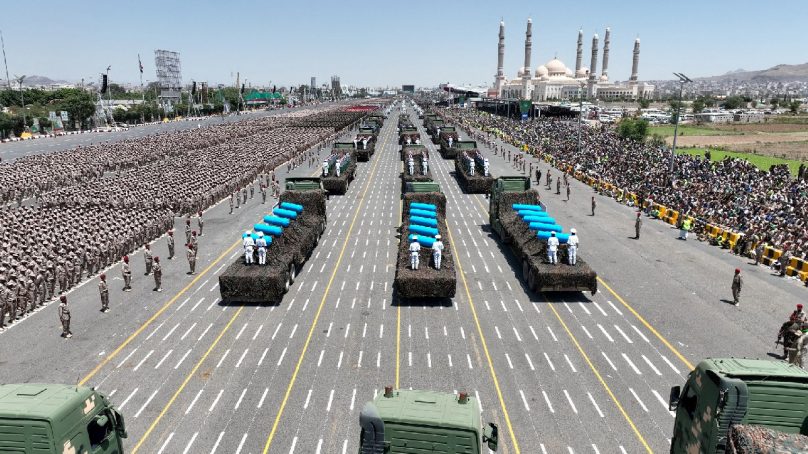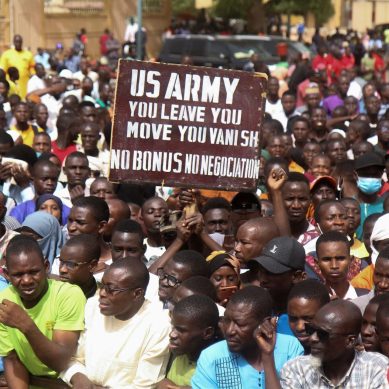
On November 29, the US Central Command (CENTCOM), which covers the Middle East, Central and South Asia announced that the destroyer USS Carney shot down an Iranian-produced KAS-04 drone – the US designation for the Samad drone – launched from Houthi-controlled areas of Yemen.
A report commissioned by the Oil Companies International Marine Forum (OCIMF), an association of petroleum firms focused on promoting safer and cleaner shipping, identified the Shahed-136 as the “loitering munition” most commonly used against merchant ships operating in the Middle East. These types of drones can circle in an area before a final target is determined.
The Shahed was employed for the first time by the Houthis in Yemen’s war between September and December 2020, according to the report, published in August and produced by global risk analysts Sibylline.
The Shahed-136 , which has been extensively used by Russian forces in Ukraine, can be fired from truck-mounted containers at a slightly upward angle. A small rocket booster helps propel the drone into the air before being jettisoned. Its main piston engine then takes over to power the flight.
An illustration shows how the Shahed-136 is launched from a trailer using a small rocket for initial boost before its engine starts.
The drone will travel towards coordinates it has been assigned. Loitering munitions usually have a navigation system to calculate their speed and position, and sometimes possess sensors connected to commercial satellite networks.
Images released in November 2022 of a Shahed-136 used to attack the MV Pacific Zircon off the coast of Oman indicated a satellite receiver on board, which could enable real-time navigation, according to the OCIMF paper. This technology might also allow Houthi operators to manually alter target coordinates in-flight.
Some models constructed with hexagonal honeycomb material inside.
Once the drone has passed any obstacles and cleared the coast it can take a lower flight path to try to avoid radar. The delta-wing design of the Shahed-136 gives it a low radar signature. Combined with its ability to travel at low-altitude, this makes detection by commercial radar difficult.
As the noisy drone approaches target areas, the distinctive sound of its small piston engine can be heard, resembling the noise of a moped. They are also relatively slow.
Taimur Khan, regional head of operations in the Gulf for Conflict Armament Research, an investigative organisation that tracks weapons used in conflicts, said Houthi drones documented during the civil war were designed to hit static targets by using GPS coordinates. But the shipping attacks appeared more sophisticated.
“In order to reliably hit a moving target such as a cargo ship, even a relatively slow-moving one, there would need to be some kind of terminal guidance,” he said.
Once a target has been acquired, loitering munitions can adjust trajectory, and attack from the top-down, detonating upon impact.
Lebanese Shia group Hezbollah – another member of Iran’s ‘Axis of Resistance’ in the Middle East – has provided military training and assistance to the Houthis, military and regional experts say. The Houthis have denied this. Hezbollah has not commented.
Eyal Pinko, a former senior official with Israel’s intelligence services until 2017 who now works at Bar Ilan University’s Begin-Sadat Centre for Strategic Studies, said Hezbollah had in particular helped the Houthis to build their naval capabilities.
These include seven naval bases and 30 control posts along Yemen’s coast that have radar and electro-optical directors for better control of missile launches, said Pinko, who has studied the Houthis since 2004.
“It’s a massive coastal defence line for detection, and they’re also using AIS (ship tracking) systems, and also intelligence from Iran,” Pinko said. Automatic identification system, or AIS, is a transponder system that allows maritime authorities and companies to publicly track commercial shipping and identify vessels.
Among the unused weapons in the Houthis arsenal are Iranian-made Sadaf floating mines. While such munitions are relatively unsophisticated and easy to deploy, their impact on merchant shipping would be considerable if they were used in the Red Sea, said Pinko, who also consults on private-sector security.
Floating mines have been placed with great effect in the Black Sea during the war in Ukraine, sowing alarm amongst shipping companies and their insurers.
The United States, Britain, and other allied nations, have carried out strikes from the air and sea against Houthi military targets in Yemen in response to the attacks on shipping.
The first wave of strikes were conducted on January 11: overnight attacks by the US and Britain targeting almost 30 different locations in Yemen. Strikes continued throughout January. The Pentagon says it has struck anti-ship missiles on the ground, as well as coastal radar and Houthi air surveillance capabilities and weapon storage sites.
Satellite images taken by Maxar Technologies the day after the Jan.11 strikes show the aftermath. In a compound on the Yemeni coast, bordering the southern Red Sea, craters and scorched earth can be seen. A similar image from Google Earth, taken by Airbus, shows structures in the same location in July last year.
One kilometer north along the coast, a similar compound was struck during the same wave of attacks on January 11. Images from Maxar Technologies show scattered debris and structures missing, when compared to a July 2 Airbus image.
Maxar also published images of locations on the outskirts of Sanaa airport showing what appears to be damage when compared to older images. One was described by Maxar as a radar facility, while the other location was unspecified.
Reuters was unable independently to determine the use of the sites or whether they were hit by Western missiles. However, both appear to have been targeted with accuracy.
CENTCOM has said US strikes have hit a number of Houthi anti-ship missiles that were about to be launched.
“This is quite difficult from an intelligence and targeting perspective because you need to know where the missile is, where it’s moving, where they want to fire it from,” said Hinz, the IISS research fellow.
“That indicates that the Americans are having some success,” he added. “We still don’t know to what degree they’ve degraded the (Houthi) arsenal.”
Shipping companies have been re-routing some sailings via Africa’s southern Cape of Good Hope as the attacks continued. The disruption threatens to drive up delivery costs for goods, raising fears it could stoke global inflation.
Container shipping, which transports consumer goods, has been the segment most impacted by the attacks in the Red Sea due to fixed routes through the waterway. In the period from the start of December last year to January 30, 373 container ships are estimated to have re-routed around Africa, according to analysis from supply chain platform project. The number of container vessels sailing through the Suez Canal has fallen by about 65 per cent since the attacks began, project44 data showed.
Because of the high risks, seafarers are signing agreements to receive double pay when entering the high-risk zones around Yemen, according to contract agreements and union officials.
“There is a fair degree of trepidation from the seafarers because quite a few ships are being hit,” said Stephen Cotton, General Secretary of the International Transport Workers’ Federation, the leading union for seafarers.
“The feedback from the captains is, certainly on the container trades, they’re much happier to go around the Cape.”
An example of re-routing from Singapore to Rotterdam.
The Suez Canal is used by roughly one third of global container ship cargo. Redirecting ships around the southern tip of Africa is expected to cost up to $1 million in extra in fuel for every round trip between Asia and northern Europe.
Worries about potential disruption to Middle Eastern supply after the latest Red Sea attack drove oil prices higher in the first trading session of 2024.
- A Reuters report











